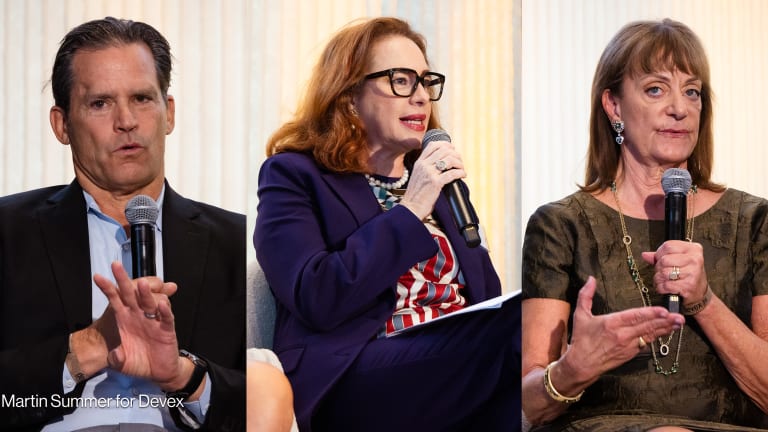
Countries and companies need to massively ramp up energy finance to ensure hundreds of millions of people can emerge from energy poverty over the next decade, Damilola Ogunbiyi, the United Nations’ special representative for sustainable energy, told Devex in an exclusive interview.
At stake is whether the world will meet the Sustainable Development Goal 7, which aims to ensure access to affordable and clean energy for all by 2030.
Part of our Focus on: People and the Planet
This series explores how climate change and other planetary imbalances impact the rising trend of human inequality. Explore the potential solutions to eliminate inequality and support a healthy planet.
About 800 million people around the world are without access to electricity, out of which 72% are in Africa. There are also 2.8 billion people globally — a third of the world’s population — who don’t have access to clean cooking solutions, and 900 million of them are in Africa, according to an October 2020 analysis from Sustainable Energy For All, an international organization set up by the U.N. to help achieve SDG7.
Tackling these problems requires $41 billion per year, Ogunbiyi said. But only about $16 billion comes through each year, either through development finance institutions, private funds, or commercial channels, said Ogunbiyi, who is also the CEO at Sustainable Energy For All. Of that $16 billion, about $4.5 billion goes to African countries, and only about $130 million is allocated to improve access to clean cooking solutions, which is a key driver of climate change.
“We are far behind from meeting the goal — we are not doing well at all,” Ogunbiyi said. “Finance is key, or else nothing will happen. It doesn’t matter how great policies are.”
A recent assessment from the International Energy Agency, which tracks progress on meeting SDG7, estimated that Sub-Saharan Africa is likely to have seen an increase in the number of people without access to electricity last year for the first time since 2013, largely due to pandemic-related economic difficulties. Final numbers for 2020 have not yet been released.
“Mobilising development finance institutions and donors is critical to ensuring that energy access progress continues,” the agency wrote.
If financing doesn’t increase to meet the actual needs, between 620 and 690 million people will still be without electricity access by 2030, Ogunbiyi said.
Furthermore, if today’s pledged policies continue at their current pace, 50% of the global population without access to power will be concentrated in seven countries by the end of this decade — the Democratic Republic of Congo, Nigeria, Uganda, Pakistan, Tanzania, Niger, and Sudan — the IEA found.
“We have to think about how we define energy access and not just assume because people don't have something at all, anything will do.”
— Damilola Ogunbiyi, special representative for sustainable energy, United NationsAn urgent problem
“There’s not a clear understanding of how urgent this is,” said Ogunbiyi, who was also the first female managing director of the Nigerian Rural Electrification Agency and the first woman to be appointed general manager of the Lagos State Electricity Board.
Ogunbiyi was appointed special representative for sustainable energy in 2019 and took on her role last year, when she was also picked as CEO at Sustainable Energy for All. During her time in Nigeria, she was responsible for the deployment of solar mini grids and solar home systems across the country to tackle energy poverty.
“I'm always going to push for the urgency,” Ogunbiyi said. “I'm always going to upset people with some of my messaging because I want people to hold me accountable, so I'm going to hold other people accountable.”
While the world is focused on cutting emissions, she said, there’s less attention paid to providing alternatives, especially in the developing world. “To resolve the climate crisis, people have to come out of poverty, and it should be in a clean, sustainable way by providing enough financing.”
The other problem is that some officials and the public have a distorted understanding of what electrification means. Ogunbiyi referenced photographs circulating on the internet showing people gathered around a lantern to show communities are gaining access to lighting.
“You're honestly telling me that that has transformed somebody's life? It will make their lives better, don't get me wrong. It might be good for security, but don't tell me that is electrification,” she said. “I take offense when people think lighting is electrification.”
Lack of electricity can be a matter of life and death in some cases. About 25% of health care centers in Africa don’t have access to power sources, which poses challenges for refrigerating vaccines, Ogunbiyi said.
Electrifying hospitals can reduce mortality rates for babies, and access to power can also empower small businesses. For example, electrifying workplaces, where people spend a large chunk of their day, means they can do their jobs better and earn the cash that would allow them to afford electricity at home.
The bottom line is that “we have to think about how we define energy access and not just assume because people don't have something at all, anything will do,” she added.
A great opportunity to rethink how to increase energy access will be at the high-level dialogue on energy in New York in September as part of the U.N. General Assembly. The event — which Ogunbiyi described as the first of its kind in decades — is meant to feed into the debate at COP 26 in Glasgow in November.
It will focus on the global action needed to ensure the world achieves the SDG7 by 2030 and net-zero emissions by mid-century. The goal is for countries, companies, and civil society to come together and outline action plans for boosting access to clean power and transition to renewables.
This focus area, supported by the U.N. Development Programme, explores how climate change and other planetary imbalances impact the rising trend of human inequality and vice versa. Visit the Focus on: People and the Planet page for more.









